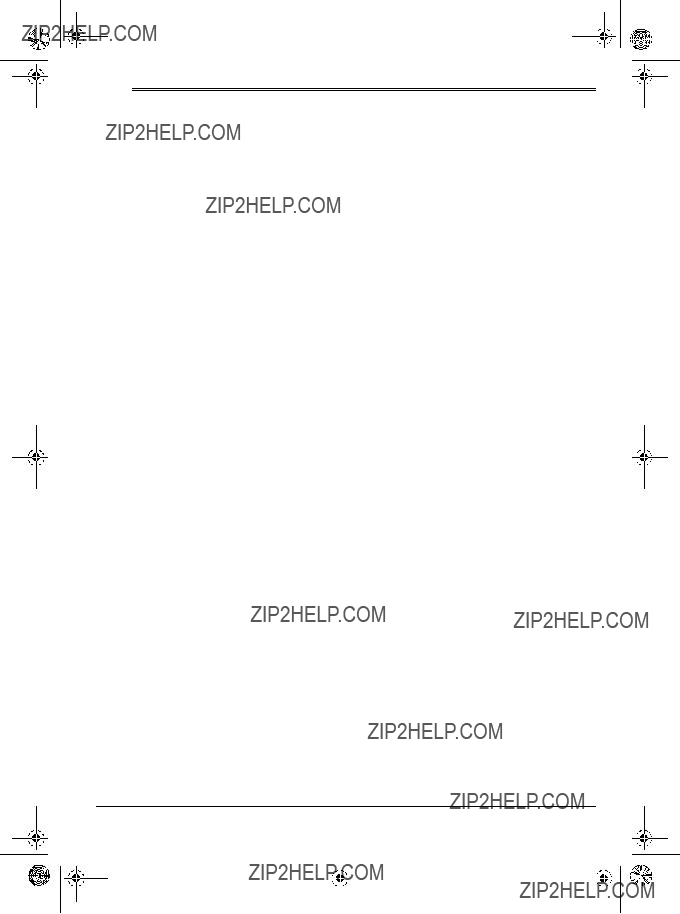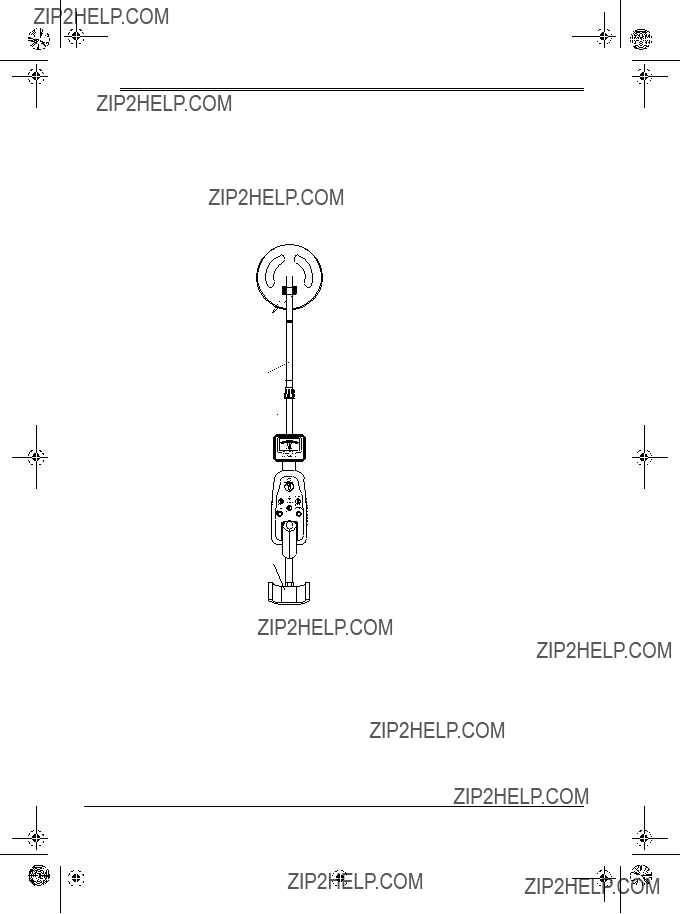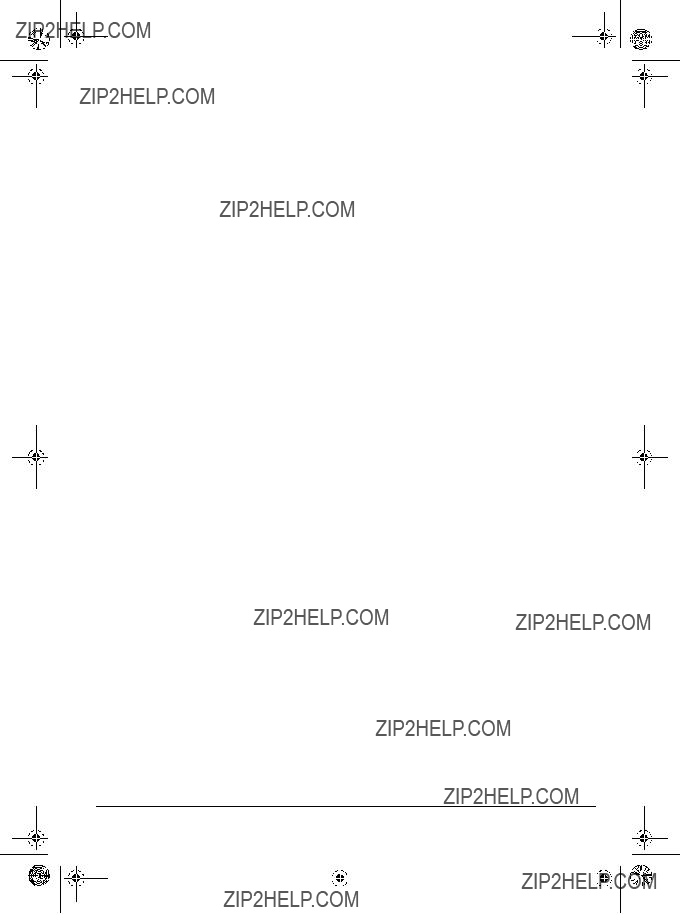
Detector Metal
AM 9:42 2000 26, July Wednesday,
Owner???s Manual
Please read before using this equipment.

Detector Metal
AM 9:42 2000 26, July Wednesday,
Owner???s Manual
Please read before using this equipment.

?? 2000 RadioShack Corporation.
All Rights Reserved.
RadioShack and RadioShack.com are trademarks used by RadioShack Corporation.
2

?? Features
With your RadioShack Metal Detector, you can hunt for coins, relics, jewelry, gold, and silver just about anywhere. The Metal Detec- tor is versatile and easy to use. Its features include:
Analog Meter??? shows the probable type of metal being detected.
Auto Tune ??? lets you tune your detector quickly for accuracy.
Arm Support ??? lets you carry and operate your detector comfortably.
Waterproof Search Coil ??? lets you use the detector to search under water. (The search coil is waterproof, but the detector???s control housing is not waterproof.)
Adjustable Stem ??? lets you adjust the de- tector???s length for comfortable use.
Headphone Jack ??? lets you connect head- phones (not supplied) to the detector.
Low Battery Indicator ??? lets you know when it is time to replace the batteries.
TREASURE HUNTER???S
CODE OF ETHICS
All treasure hunters might be judged by the example you set. Here are a few basic rules you should follow while using your detector.
???Always get permission before searching any site.
???Respect the rights and property of oth- ers.
???Observe all national, state, and local laws while treasure hunting.
???Never destroy historical or archaeologi- cal treasures. If you are not sure about an object you have found, contact a museum or historical society in your area.
???Leave the land and vegetation as it was. Fill in any holes you dig.
???Use your detector only in safe areas.
???Dispose of any junk you find, only in approved areas. Do not leave it for the next treasure hunter to find.

?? Preparation
ASSEMBLING THE
DETECTOR
Assembling your detector is easy and re- quires no special tools. Just follow these steps.
1. Turn the stem???s lock nut clockwise until it loosens.
2. Lengthen or shorten the stem so when you stand upright with the detector in your hand, the search coil is level with and about 1/2 to 2 inches above the ground with your arm relaxed at your side.
3. Turn the stem???s lock nut
4. Unscrew the knobs on the search coil and remove the knobs and connec- tor. Insert the stem
and align the holes on the search coil bracket and the stem.
Push the connector through the holes, then replace and tighten the knobs.
5.Wind the search coil cable around the stem. Leave enough slack in the cable to let you adjust the search coil when you are hunting on uneven ground.
6.Insert the search coil???s plug into the search coil jack on the detector???s control
housing so the pins on the plug are aligned with the holes in the jack.
Cautions:
???The search coil???s plug fits into the connector only one way. Do not force the plug or you could damage it.
???To disconnect the search coil???s cable from the detector, grasp the plug and pull it out of the connector. Never pull on the cable.
7.Loosen the knob at the search coil???s end, then adjust the search coil to the desired angle. (The search coil should be parallel with the ground.) Tighten the knob just enough to keep the search coil from rotating or wobbling.
Caution: Do not overtighten the search coil or use tools such as pliers to tighten it.
8.Loosen the knob at the base of the han- dle, insert the arm support, and tighten the knob.
INSTALLING BATTERIES
Your detector requires two 9V alkaline bat- teries (not supplied) for power. For the best performance and longest life, we recom- mend RadioShack alkaline batteries.
Cautions:
???Use only fresh batteries of the required size and recommended type.
???Do not mix old and new batteries, differ- ent types of batteries (standard, alka- line, or rechargeable), or rechargeable batteries of different capacities.

1.If the detector is on, turn MODE to OFF.
Note: When you turn the mode switch to OFF, the LOW BATT indicator flashes once.
2.Press the right battery compartment cover???s tab and slide the cover off in the direction of the arrow.
3.Place a
4.Replace the right battery compartment cover.
5.Press the left battery compartment cover???s tab and slide the cover off in the direction of the arrow.
6.Place a
7.Replace the left battery compartment cover.
Warning: Dispose of old batteries promptly and properly. Do not burn or bury them.
Caution: If you do not plan to use the detec- tor for a week or more, remove the batteries. Batteries can leak chemicals that can de- stroy electronic parts.
Notes:
???For better life, exchange the two batter- ies periodically.
???You can extend battery life by using headphones, which require less power than the
If the LOW BATT indicator lights during nor- mal use or the detector does not function properly, replace the batteries. If it still does not function properly, you might need to re- set the detector.
USING HEADPHONES
You can connect a pair of stereo head- phones (not supplied) to the detector so you can listen to it privately. Using headphones also saves battery power and makes it easier to identify subtle changes in the sounds you hear, for better detection results. Your local RadioShack store has a wide selection of headphones.
To connect head- phones to the de- tector, insert the
ternal speaker disconnects when you con- nect headphones.
Listening Safely
To protect your hearing, follow these guide- lines when you use headphones.
???Set the volume to the lowest setting before you begin listening. After you begin listening, adjust the volume to a comfortable level.

???Do not listen at extremely high volume levels. Extended
???Once you set the volume, do not increase it. Over time, your ears adapt to the volume level, so a volume level that does not cause discomfort might still damage your hearing.
Traffic Safety
Do not wear headphones while operating a motor vehicle or riding a bicycle. This can create a traffic hazard and could be illegal in some areas.
Even though some headphones let you hear some outside sounds when listening at nor- mal volume levels, they still can present a traffic hazard.
?? A Quick Look at Your Metal Detector
MODE ??? lets you select from OFF, VLF, TR1, TR2. (See ???Turn- ing On the Detector??? on Page 7.)
GROUND ??? compensates for false signals from mineralized soil. (See ???Adjusting Ground??? on Page 9.)
VOLUME ??? lets you adjust the volume of alert tones.
DISCRIMINATION ??? lets you ad- just the metal detector???s ability to distinguish between different types of metal. (See ???Adjusting Discrimination??? on Page 9.)
Analog Meter
 LOW BATT Indicator
LOW BATT Indicator
SENSITIVITY ??? lets you adjust




 the detection depth. (See ???Ad-
the detection depth. (See ???Ad- 


 justing Sensitivity??? on Page 9.)
justing Sensitivity??? on Page 9.)
TUNING ??? adjusts the balance between the receiver and trans- mitter. (See ???Tuning the Detec- tor??? on Page 7.)

?? Operation
Your RadioShack Metal Detector distinguish- es between ferrous and
When the detector senses a metallic object, the meter reading changes and the detector sounds one of three tones. The tone de- pends on what metal is detected. The higher the tone???s pitch, the stronger the detection.
PREPARING THE
DETECTOR
Turning On the Detector
Hold the detector in a comfortable position, then rotate MODE to the desired position.
VLF (Very Low Frequency) ??? to adjust TUNE and GROUND. (See ???Adjusting Ground??? on Page 9 and ???Tuning the Detector??? below.)
??? to detect extreme differ- ences in metals, such as iron and gold. The difference between iron and gold shows on the meter (iron in the ferrous section, gold in the
TR2 (Transmit 2) ??? to detect finer distinctions between metals, such as aluminum and gold (see ???Adjusting Discrimination??? on Page 9).
Tuning the Detector
TUNE
1.Rotate VOLUME to the 10 o???clock posi- tion.
2.Set MODE to VLF.
3.Set GROUND, DISCRIMINATION, and
SENSITIVITY to
4.Hold the search coil at least 1 foot away from the ground and any metal object, hold down the red button on the handle and slowly rotate TUNE until the analog meter pointer resets at or near 0.
As you search, you can
Note: Press the red button on the handle at any time during operation to automatically re- turn the pointer to the center of the analog meter.
TESTING AND USING THE
DETECTOR
To learn how the detector reacts to different metals, you should test it before you use it the first time. You can test the detector in- doors or outdoors.
Indoor Testing
1.Remove any watches, rings, or other metal jewelry you are wearing, then place the detector on a wooden or plas- tic table.
2.Adjust the search coil???s angle so the flat part faces the ceiling.
Note: Never test the detector on a floor inside a building. Most buildings have metal of some kind in the floor, which might interfere with the objects you are testing or mask the signal completely.
3.Set MODE to TR1.
4.Move a sample of the material you want the detector to find (such as a gold ring

or a coin) about 2 inches above the search coil.
Notes:
???The search coil will not detect without motion. You must move the object since you are not sweeping with the detector at this time.
???If you are using a coin, the detector detects it more easily if you hold it so a flat side (not the edge) is parallel with the flat side of the search coil.
If the detector detects the material, the point- er moves to FERROUS or
while the detector determines the type of metal it is detecting. If it detects
If the detector does not detect the material, check the LOW BATT indicator and verify that the search coil is properly connected. Al- so, you might need to
Outdoor Testing and Use
1.Find an area on the ground outside where there is no metal.
2.Place a sample of material you want the detector to find (such as a gold ring or a coin) on the ground. (If you are using valuable metal such as gold to test the detector, mark the area where you place the item, to help you find it later. Do not place it in tall grass or weeds.)
3.Set MODE to TR1.
4.While holding the search coil level about
Search Coil Sweeping Hints:
???Never sweep the search coil as if it were a pendulum. Raising the search coil while sweeping or at the end of a sweep causes false readings.
???Sweep slowly; hurrying makes you miss targets.
If the detector detects the item, it sounds a tone and the pointer moves to the type of metal it found. When you detect metal, switch MODE TR1 to TR2 to deter- mine the quality of the metal.
If the detector does not detect the mate- rial, make sure you are moving the search coil correctly.
Notes:
???The detector responds with a strong signal when it detects most valuable metal objects. If a signal does not repeat after you sweep the search coil over the target a few times, the target is probably junk metal.
???False signals can be caused by areas containing large amounts of trash, electrical interference, or large irregu- lar pieces of junk metal. False signals are usually broken or
5.Try finding other metal in the area. When you find a metal item, wait a few seconds after the tone stops before con- tinuing to allow the detector time to reset (or, press the red button on the handle to return the pointer to the center of the analog meter).

DETECTOR
After you become familiar with how your de- tector works, you can
Adjusting Sensitivity
To adjust the search coil???s ability to detect objects at different depths in the soil, rotate
SENSITIVITY between MIN and MAX. For maximum detection depth, leave SENSITIVI- TY set as high as possible. If the detector makes a ???chattering??? noise, decrease SENSI- TIVITY until the chatter stops.
Adjusting Ground
Setting GROUND takes a little time, but is crit- ical for accurate operation. GROUND tunes out false signals from mineralized soil. Fol- low these steps to set GROUND.
1.Set MODE to VLF and lower the search coil to 1/2 to 2 inches above the ground.
2.If the pointer swings to the right (Non- ferrous), turn GROUND to NORMAL. If the pointer swings to left (Ferrous), turn
GROUND to BASALT.
3.Raise the search coil about 1 foot from the ground and press the red button on the handle. The pointer returns to the center.
4.Repeat Steps
After you set GROUND, the detector is set for the soil type at that particular site. Do not re- set it until you use the detector at a different site.
Adjusting Discrimination
Discrimination is the detector???s ability to dif- ferentiate between types of metal. The de- tector???s DISCRIMINATION setting determines whether the detector will distinguish between different types of ferrous and
If MODE is set to TR2, start with DISCRIMINA- TION set to
As you set DISCRIMINATION to higher levels, the detector first does not detect small piec- es of silver paper, then thick foil, and finally metal objects like pull tabs from aluminum cans.
Note: Each time you use the detector in a different area, you must readjust
NATION. Each search location presents new challenges.
FALSE SIGNALS
Because your detector is extremely sensi- tive,
To reduce false signals when searching ar- eas containing large amounts of trash, scan only a small area at a time using slow, short overlapping sweeps.

DETECTION HINTS
No detector is 100 percent accurate. Various conditions influence metal detection. The de- tector???s reaction depends on a number of factors:
???the angle at which the object rests in the ground
???the depth of the object
???the amount of iron in the object
???the size of the object
PINPOINTING A TARGET
Accurately pinpointing a target makes dig- ging it up easier. This takes practice, and we suggest you practice finding and digging up small metal objects on your own property be- fore you search other locations.
Sometimes, targets are difficult to accurately locate due to the sweep direction. Try chang- ing your sweep direction to pinpoint a target.
1.When the detector locates a buried tar- get, continue sweeping the search coil over the target, in a narrowing
2.Make a visual note of the exact spot on the ground where the detector beeps.
3.Stop the search coil directly over this spot on the ground. Then move the search coil straight away from you and straight back toward you a couple of times.
4.Make a visual note of the exact spot on the ground where the detector beeps.
5.Repeat Steps
Notes:
???If trash in an area is so heavy that you get false signals, slow your sweep speed and use shorter sweeps.
???Recently buried coins might not respond the same as coins buried for a long period of time because of oxidation.
???Some nails, nuts, bolts, and other iron objects (such as old bottle caps) oxidize and create a ???halo??? effect. A halo effect is caused by a mixture of natural ele- ments in the ground and the oxidation created by different metals. Because of the metal mixtures, target signals might not be in a ???fixed??? position. This effect makes these objects very hard to detect accurately. (See

?? Troubleshooting
If your detector is not working as it should, follow these suggestions to see if you can eliminate the problem. If you can???t, take the detector to your local RadioShack store for assistance.
?? Care
Keep the metal detector dry; if it gets wet, wipe it dry immediately. Use and store the metal detector only in normal temperature environments. Handle the metal detector carefully; do not drop it. Keep the metal de- tector away from dust and dirt, and wipe it with a damp cloth occasionally to keep it looking new.
Modifying or tampering with the metal detec- tor???s internal components can cause a mal- function and might invalidate its warranty. If
your metal detector is not performing as it should, take it to your local RadioShack store for assistance.
The search coil supplied with the detector is waterproof and can be submerged in either fresh or salt water. However, do not let water enter the detector???s control housing. After us- ing the search coil in salt water, rinse it with fresh water to prevent corrosion of the metal parts.

Limited
This product is warranted by RadioShack against manufacturing defects in material and workman- ship under normal use for ninety (90) days from the date of purchase from RadioShack company- owned stores and authorized RadioShack franchisees and dealers. EXCEPT AS PROVIDED HEREIN, RadioShack MAKES NO EXPRESS WARRANTIES AND ANY IMPLIED WARRANTIES,
INCLUDING THOSE OF MERCHANTABILITY AND FITNESS FOR A PARTICULAR PURPOSE,
ARE LIMITED IN DURATION TO THE DURATION OF THE WRITTEN LIMITED WARRANTIES CONTAINED HEREIN. EXCEPT AS PROVIDED HEREIN, RadioShack SHALL HAVE NO LIABIL-
ITY OR RESPONSIBILITY TO CUSTOMER OR ANY OTHER PERSON OR ENTITY WITH RE-
SPECT TO ANY LIABILITY, LOSS OR DAMAGE CAUSED DIRECTLY OR INDIRECTLY BY USE
OR PERFORMANCE OF THE PRODUCT OR ARISING OUT OF ANY BREACH OF THIS WAR-
RANTY, INCLUDING, BUT NOT LIMITED TO, ANY DAMAGES RESULTING FROM INCONVE-
NIENCE, LOSS OF TIME, DATA, PROPERTY, REVENUE, OR PROFIT OR ANY INDIRECT, SPECIAL, INCIDENTAL, OR CONSEQUENTIAL DAMAGES, EVEN IF RadioShack HAS BEEN AD-
VISED OF THE POSSIBILITY OF SUCH DAMAGES.
Some states do not allow limitations on how long an implied warranty lasts or the exclusion or limita- tion of incidental or consequential damages, so the above limitations or exclusions may not apply to you.
In the event of a product defect during the warranty period, take the product and the RadioShack sales receipt as proof of purchase date to any RadioShack store. RadioShack will, at its option, un- less otherwise provided by law: (a) correct the defect by product repair without charge for parts and labor; (b) replace the product with one of the same or similar design; or (c) refund the purchase price. All replaced parts and products, and products on which a refund is made, become the prop- erty of RadioShack. New or reconditioned parts and products may be used in the performance of warranty service. Repaired or replaced parts and products are warranted for the remainder of the original warranty period. You will be charged for repair or replacement of the product made after the expiration of the warranty period.
This warranty does not cover: (a) damage or failure caused by or attributable to acts of God, abuse, accident, misuse, improper or abnormal usage, failure to follow instructions, improper installation or maintenance, alteration, lightning or other incidence of excess voltage or current; (b) any repairs other than those provided by a RadioShack Authorized Service Facility; (c) consumables such as fuses or batteries; (d) cosmetic damage; (e) transportation, shipping or insurance costs; or (f) costs of product removal, installation,
This warranty gives you specific legal rights, and you may also have other rights which vary from state to state.
RadioShack Customer Relations, 200 Taylor Street, 6th Floor, Fort Worth, TX 76102